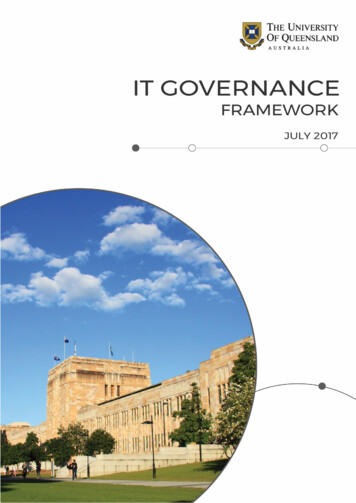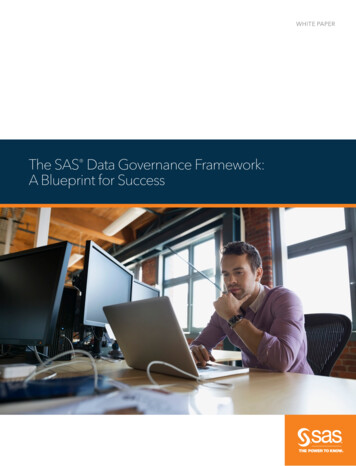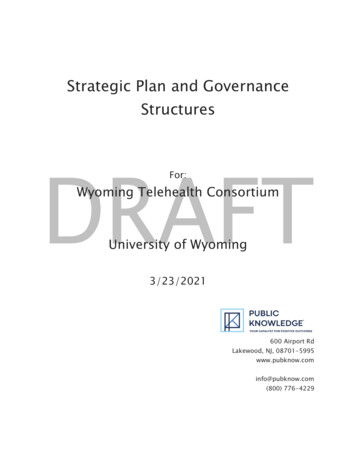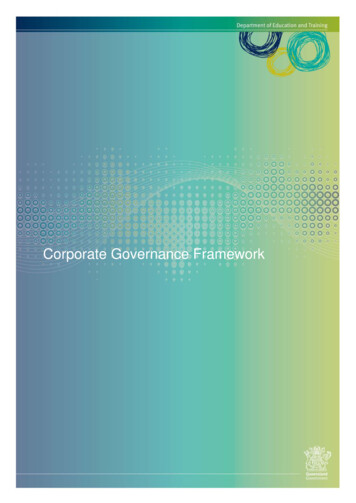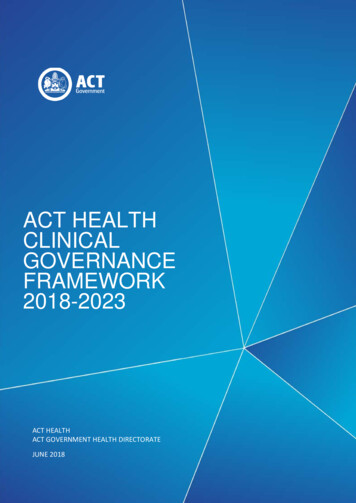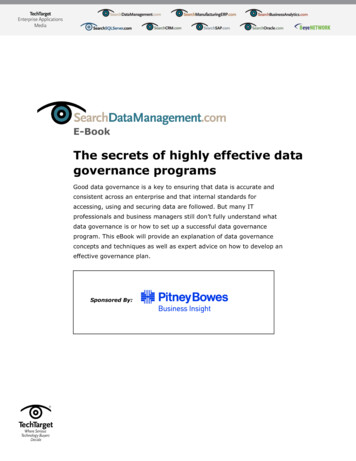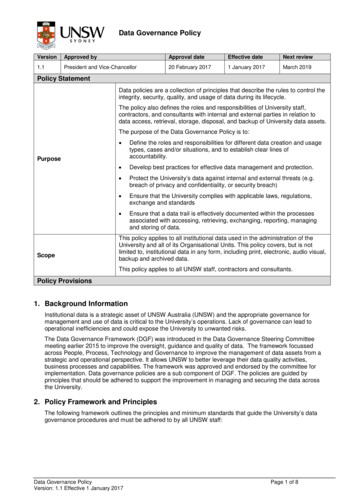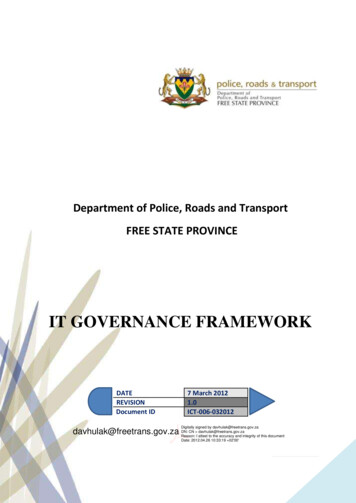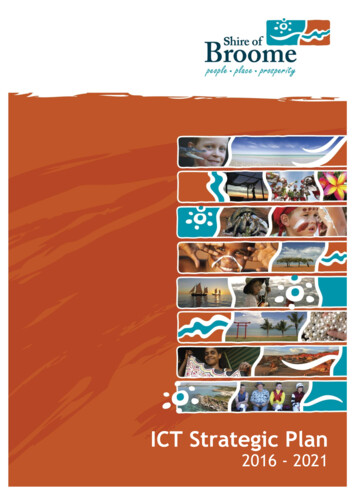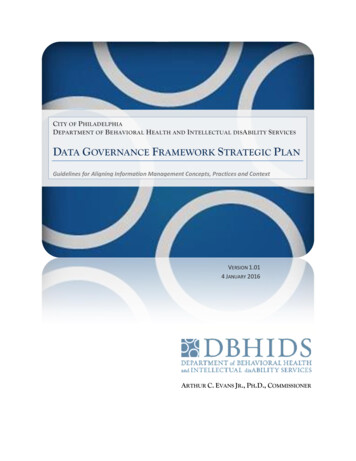
Transcription
CITY OF P HILADELPHIAD EPARTMENT OF BEHAVIORAL H EALTH AND I NTELLECTUAL DIS A BILITY SERVICESDATA GOVERNANCE FRAMEWORK STRATEGIC PLANGuidelines for Aligning Information Management Concepts, Practices and ContextVERSION 1.014 JANUARY 2016ARTHUR C. EVANS JR., PH.D., COMMISSIONER
Do – Know– Measure – Learn – RememberTABLE OF CONTENTSExecutive Summary. 3The DBHIDS Data Governance Framework Strategic Plan . 5The Case for Information Architecture . 5Relationship to Other Architectures . 5Data Governance and Its Relationship to Information Architecture . 6The Importance of an Architectural Framework . 7The Relationship between a Data Governance Framework and the DAMA DMBOK . 8Data Reusability is the Overarching Goal. 9Drivers for a Data Reusability Architecture . 10DBHIDS Data Governance Framework Strategic Plan Components . 11Information Architecture Principles. 11Data Governance Goals. 11Information Service Delivery Use Cases . 11Conceptual Information Architecture Schema . 11DBHIDS Information Architecture Principles . 12DBHIDS Data Governance Goals . 14DBHIDS Information Service Delivery Use Cases . 16DBHIDS Conceptual Information Architecture . 18References . 20Credits . 20DBHIDS 2015 – All Rights ReservedDaniel J. Paolini, CIO – with input from the Data Architecture Coordination Team“We are drowning in information but starved for knowledge. Uncontrolled and unorganizedinformation is no longer a resource in an information society, instead it becomes the enemy.”— John Naisbitt, Megatrends: 10 New Directions Transforming Our Lives (1982)Page 2 of 20Data Governance Framework Strategic Plan v1.014 January 2016
Do – Know– Measure – Learn – RememberEXECUTIVE SUMMARYInformation Technology is the Information, Applications and Infrastructure necessary to meet the needsof the Business. Of these, the most important resource is the information asset. It is this informationthat represents a model of the functioning business over time. Infrastructure and applications change toreflect changes in technology or process, but the data that records the transactions of key entities withthe business must be logically defined and maintained so that it is consistent, persistent and useful.Over time, the ability for data systemsto support business processes in thepursuit of business goals degradesbecause data quality degrades. Thisresults in more cost but less benefit.Attempting to fix these problems at theoperational level will not work. Addingmore data and data systems in an effortto “fix” these problems only makesthem worse.What will fix these problems is notmore technology, more systems ormore data, but Data Governance. DataGovernance advances the goal of“Reusable Data”; data that is timelier,more accurate, more complete, moreaccessible, more useful and less costly.Data Governance is not a technologyfunction. It is driven by the business andforms a bridge between businessmanagement and technology providers.Executive Sponsorship comes from thebusiness. Data Governance and DataStewardship represent collaborations ofbusiness subject matter experts andinformation architecture staff. DataManagement is provided by varioustechnologists overseen by an enterpriseinformation management unit.The Data Governance Framework represents the desired future-state needed to address the problemsthat compromise our information asset today. It documents the Department’s Information Architecture.Taking our cue from the Practice Guidelines, we will align information management concepts, practicesand context.4 January 2016Data Governance Framework Strategic Plan v1.01Page 3 of 20
Do – Know– Measure – Learn – RememberThe Data Governance Framework Strategic Plan includesTen information architecture principles that inform the development of strategies to meet theinformation needs of the organization and will continue to guide their implementation:1. Information architecture is the reflection of the business; it is not a just technology domain.2. The identification and definition of data attributes must involve the business.3. Data is an organizational asset and must be managed with an enterprise perspective.4. Data that is common to more than one business unit must be defined through the consensus ofrepresentatives of those business units.5. The value of data to the enterprise is in its fitness for reusability, not its exclusivity.6. The value of data management staff is in its ability to build high quality, reusable data assets.7. Different information use cases require different data management solutions.8. In order to be sustainable, physical data stores must be governed by a logical understanding ofthe enterprise, captured in a logical business model.9. The purpose of a data management organization is to produce a data product that meets theinformation needs of the business commensurate with the investment made by the business.10. If it isn’t documented it doesn’t exist; if it can’t be measured it has no value.Nine data governance goals that describe concrete, action-oriented targets that categorize and focusinformation management efforts1. Create an information-centric and informed organizational culture.2. Establish a data governance program to provide accountability for information assets.3. Provide for effective and appropriate information security.4. Improve the quality and usefulness of information by making it timelier, more accurate,more complete and more accessible.5. Reduce the costs of managing information.6. Share data through reusable processes; reuse data through shared processes.7. Provide self-service business intelligence capabilities.8. Develop enterprise-class data management staff.9. Adopt enterprise-class data management tools.Five information service delivery use cases that drive the selection of appropriate methodologies andtechnologies to meet the business needs of the department1. Transactional Processing: “To Do”2. Operational Reporting: “To Know”3. Data Integration and Persistence: “To Remember”4. Key Performance Indicators: “To Measure”5. Analytical Reporting: “To Learn”In addition, there is a companion Data Governance Framework Implementation Plan.Page 4 of 20Data Governance Framework Strategic Plan v1.014 January 2016
Do – Know– Measure – Learn – RememberTHE DBHIDS DATA GOVERNANCE FRAMEWORK STRATEGIC PLANGuidelines for Aligning Information Management Concepts, Practice and ContextTHE CASE FOR INFORMATION ARCHITECTUREData is the fundamental building block of Digital Government. It is a critical resource and we mustmanage it as such. We must transform the practice of creating isolated islands of data to satisfyindividual programs or units. We must manage a core of common data at the enterprise level. We mustmanage all data with common tools and methodologies. This will make it possible to use datamanagement technologies to collect, publish, and maintain the integrity of critical data elements acrossmultiple programs in a manner that is both efficient and responsive to business needs. Formalinformation architecture is essential to achieving this.Information architecture is a component or perspective of theenterprise architecture. Information architecture representsthe reference architecture for an enterprise datamanagement program. Reference architectures describe thevision, goals, objectives, principles, practices, standards,methodologies, and tools used in a particular technologydomain within an organization. The data managementdomain encompasses the collection, definition, andmaintenance of data and the development and presentationof actionable information derived from that data.RELATIONSHIP TO OTHER ARCHITECTURESIn order to place domain architectures such as the DataGovernance Framework in context, it is essential toacknowledge one overarching relationship:The DBHIDS Data Governance Framework is one ofthree domains (components) of the overall DBHIDSEnterprise Architecture.This Enterprise Architecture consists of three relatedarchitecture domains: Enterprise ArchitectureEnterprise architecture (EA) is a well-definedpractice for conducting enterprise analysis,design, planning, and implementation, usinga holistic approach at all times, for thesuccessful development and execution ofstrategy.EA applies architecture principles andpractices to guide organizations through thebusiness,information,process,andtechnology changes necessary to executetheir strategies. These practices utilize thevarious aspects of an enterprise to identify,motivate, and achieve these changes.Normally an organization’s EA takes theform of a comprehensive set of cohesivemodels that describe the structure andfunctions of an enterprise. The individualmodels in an EA are arranged in a logicalmanner that provides an ever-increasinglevel of detail about the enterprise.en.wikipedia.org/wiki/Enterprise architectureBusiness Process (the business operations)Information (the data), represented by this Data Governance FrameworkTechnology (the hardware and software)The Business Process Architecture provides the essential functionality of the business; what it means tobe the business. The Information Architecture guides the development of data necessary for theBusiness Process Architecture; what it means to be of interest to the business. The TechnologyArchitecture is established to deliver the components required by the Information and Business ProcessArchitecture. Of these, the Information Architecture is the least volatile and most long-lasting.4 January 2016Data Governance Framework Strategic Plan v1.01Page 5 of 20
Do – Know– Measure – Learn – RememberCollectively, these domains craft theSolution Architecture for a specificbusiness problem.Without anunderstanding of these crucialrelationships, business users andtechnologists cannot help but createthe islands of disintegration thatEnterprise Architecture is chargedwith preventing.Business ployBuildTechnologyArchitectureDATA GOVERNANCE AND ITS RELATIONSHIP TO INFORMATION ARCHITECTUREInformation Architecture describes what, when, where and why; in other words, the domain of datamanagement. Data Governance describes who and how; in other words, roles and responsibilities.Broadly speaking, Data Governance is the exercise of decision‐making and authority for data‐relatedmatters. Formal Data Governance is a system that provides rules and policies proactively to enableongoing efficient service delivery while providing mechanisms to address data quality issues as they areidentified.Data Governance also refers to the organizational bodies, rules, decision rights, and accountabilities ofpeople and information systems as they perform information‐related processes. In other words, DataGovernance is the identification of those with decision-making responsibility for data management.Data Governance is not a technologyfunction. It is driven by the business andforms a bridge between businessmanagement and technology providers.Executive Sponsorship comes from thebusiness. Data Governance and DataStewardship represent collaborations ofbusiness subject matter experts andinformation architecture staff. DataManagement is provided by varioustechnologists.Page 6 of 20Data Governance Framework Strategic Plan v1.014 January 2016
Do – Know– Measure – Learn – RememberTHE IMPORTANCE OF AN ARCHITECTURAL FRAMEWORKArchitectural frameworks are a form of strategic planning. A good framework will document the currentstate of the organization as well as the desired state. It will plot the route for evolving from the currentstate to the desired state. In this, it provides its greatest value, as it becomes the way to “decide how todecide”. It establishes the practices that will be followed to address categories of situations.Organizations make tactical decisions every day. These can be as mundane as what to name somethingor as important as where to get authoritative information. Without a plan, the organization will notknow when one of these decisions is misaligned with the desired state.The Cynefin (ki-nev-in) Framework is an approach to management and decision-making. There are fourrealms that identify situations that require different types of practices: Obvious, Complicated, Complexand Chaotic. A fifth realm, Disorder, represents an organization without practices, just habits.The DBHIDS Data Governance Framework“pre-decides” many of the routine(obvious) decisions by prescribing bestpractices and standards. It describes agovernance structure for identifyingnovel, emergent and good practices thateventually evolve into best practices. Theframework identifies the goals, objectivesand principles that guide decision-makingabout these practices.Cynefin Decision-Making acticesDisorder – No Practices, Just HabitsThe Data Governance Frameworkrepresents a commitment to informationarchitecture as a long-term strategicinitiative to enable data reusability. Thisarchitecture forms the foundation forcollecting, storing, managing, controllingprivacy of, and providing access toenterprise data to meet business needs.ChaoticObviousNovelPracticesBestPracticesBy following the DGF, stakeholders will have access to more useful information, as they: Collect data once but use it often, improving data accuracy Store data more effectively for a timelier and morecomplete information picture Reduce or eliminate costs associated with datacollection, storage and error correction Improve access to information while betterprotecting the privacy of individuals4 January 2016Data Governance Framework Strategic Plan v1.01Page 7 of 20
Do – Know– Measure – Learn – RememberTHE RELATIONSHIP BETWEEN A DATA GOVERNANCE FRAMEWORK AND THE DAMA DMBOKThe Data Management Association (DAMA) in its Data Management Body of Knowledge (DMBOK) hasidentified ten distinct data management domains. Data Governance is one of the domains. It overarchesthe other nine domains, providing coordination and facilitating communications and planning. Below is arepresentation of the DMBOK Wheel. It illustrates that each of the nine management domains has equalvalue; no one discipline is more important than any other. It also illustrates how each of the ninemanagement domains is, however, guided by the organization’s data governance processes.DAMA Body of KnowledgeThe “body of knowledge” aboutdata management is quite largeand constantly growing. TorespondtothischallengeDAMA International provides theDAMA Guide to the DataManagement Body of Knowledge,or DAMA DMBOK, as a definitiveintroduction to data management.DAMA DMBOK defines a standardindustry view of data managementfunctions, terminology and bestpractices, without detailing specificmethods and techniques. WhileDAMA-DMBOK is not a completeauthority on any specific topic, itwill point readers to widelyrecognized publications, articlesand websites for further reading.www.dama.org/content/body-knowledgeThis DMBOK Wheel is not itself a data governance framework. It serves as an organizing scheme fordiscussing the interrelated data management disciplines and their dependence upon effective datagovernance. An organization still needs a data governance framework that reflects its principles andgoals while addressing these knowledge domains.A data governance framework provides a rational description of both our information architecture andhow we will implement it. It serves as a guide for decision-making around data, data technologies anddata management processes.The DBHIDS Data Governance Framework (DGF) represents the information architecture for theDepartment and guides its enterprise data management. It prescribes an approach to data governance,data management, data architecture and information technology to support the goal of data reusability.Page 8 of 20Data Governance Framework Strategic Plan v1.014 January 2016
Do – Know– Measure – Learn – RememberDATA REUSABILITY IS THE OVERARCHING GOALData reusability is the refocusing of data management from our traditionalsharing data bymoving it aroundapproach to one ofsharinginformationthroughreusable data.The purpose of the DBHIDS Data Governance Framework is to drive data reusability to meet theDepartment’s strategic and operational needs. In its report, “NATIONAL INFORMATION ARCHITECTURE:Toward National Sharing of Governmental Information”, the National Association of State ChiefInformation Officers (NASCIO) summarizes that “The business case for such an architecture rests on fourfoundations.” These four foundations are the ability to positively e have identified two additional foundations. These are the ability to positively impact:ACCESSIBILITYUSEFULNESSCollectively, these represent the value of information architecture and comprise the drivers for theDBHIDS Data Reusability xpensiveMoreAccessibleMoreUsefulINFORMATION ARCHITECTURE VALUE4 January 2016Data Governance Framework Strategic Plan v1.01Page 9 of 20
Do – Know– Measure – Learn – RememberDRIVERS FOR A DATA REUSABILITY ARCHITECTUREReusable Data is More AccurateReusable data increases the reliability of data transactions. Standardized lookup tablesprovide developers with a low-cost and consistent source of reference data to validate dataentry according to department standards. Reusable master entity information, retrieved onMoredemand, reduces the potential for user input errors and update anomalies that developAccuratebetween redundant data sets.Reusable Data is TimelierApplications can make updates to Master Data available to all stakeholders immediately.There is no need manually to update disparate systems, thus eliminating workflowbottlenecks. As data is integrated for reuse, reporting and analysis can take the form of selfservice. Turnaround time for new reports and requests for information is greatly reduced.TimelierLatency between data collection and the ability to report on it is also greatly reduced.Reusable Data is More CompleteReusable data enables stakeholders to access their records from a single access point. Theywill not need to work with multiple systems just because multiple business units managethose records. Developers can write applications to recognize, in an intelligent way,Moredependent processes across unit and line-of-business borders. Logical workflow can beCompleteincorporated into these applications to capture and maintain all related information.Reusable Data is Less ExpensiveThere are hundreds of data tables in DBHIDS databases that duplicate data availableelsewhere. These tables contain information as basic as county codes for lookup validation,or as critical as demographic data for entitlement programs. Centralized management ofLessuniversal information reduces the costs of creating, maintaining and reconciling multipleExpensivecontainers of the same information.Reusable Data is More AccessibleAn Enterprise Reference Data Model and corresponding metadata provide stakeholderswith the roadmap and the mechanism to interoperate electronically. Constraints on datasharing, whether valid or merely perceived, are resolved as a part of the Business ModelMorecreation and maturation process. Applications can access Reusable data to the extentAccessiblepermitted by established business rules and legal requirements.Reusable Data is More UsefulImproving decision making within the organization is accomplished through the use of selfservice reporting and Key Performance Indicator (KPI)-based dashboards. This informationcan come from multiple sources across the enterprise. To be successful, these capabilitiesMoreshould be built upon a stable enterprise data warehousing environment that ensures thatUsefulconsistent answers are retrieved regardless of report mechanism or timing of the request.Page 10 of 20Data Governance Framework Strategic Plan v1.014 January 2016
Do – Know– Measure – Learn – RememberDBHIDS DATA GOVERNANCE FRAMEWORK STRATEGIC PLAN COMPONENTSINFORMATION ARCHITECTURE PRINCIPLESAn architecture principle is a comprehensive and fundamental law,doctrine, or assumption that provides overarching guidance fordevelopment of a solution. A good architecture principle is not outdatedby advancing technology and, more importantly, provides objectivereasons for advancing it instead of alternatives. The ten informationarchitecture principles guide the identification of goals and objectivesfor our information architecture and the formation of strategies toachieve those goals and objectives.DATA GOVERNANCE GOALSGoals describe concrete, action-oriented targets that categorize and focus information managementefforts. The nine data governance goals are the heart of the department’s information architecture.Each goal has one or more objectives that align to the information architecture principles.INFORMATION SERVICE DELIVERY USE CASESInformation service delivery use cases drive the selectionof appropriate methodologies and technologies to meetthe business needs of the department. An organizationmust have a single defined source of the truth forbusiness information – not multiple versions withdifferent meanings. This is not the same as having data inonly one place or managing data through only oneprocess. To be useful, data must be managedconsistently, but with an understanding of the audienceand the purpose for the data. The five information servicedelivery use cases provide the distinctions necessary to guide information management for thedepartment. They categorize the audience and purpose of data so that the proper methodologies andtechnologies are applied while maintaining a single authoritative source for business data.CONCEPTUAL INFORMATION ARCHITECTURE SCHEMAThis schema is based upon the “Corporate Information Factory” and it illustrates the relationshipbetween the information service delivery use cases.The principles, goals and use cases are described in more detail in the sections that follow.4 January 2016Data Governance Framework Strategic Plan v1.01Page 11 of 20
Do – Know– Measure – Learn – RememberDBHIDS INFORMATION ARCHITECTURE PRINCIPLESInformation architecture is the reflection of the business; it is not just a technology domain.This principle is critical to both a successful data governance effort and to individualdata management projects. When the business abdicates responsibility for informationarchitecture and data governance to information technologists, it leads to the creationof data silos, disparate data, poor data quality and a focus on activity over value. Thebusiness must be a partner with technologists in data governance and informationarchitecture efforts.The identification and definition of data attributes must involve the business.When the business does not lead this effort, there is a loss of understanding over timethat can neither be fixed nor replaced through the efforts of information technologistsalone. For business-critical data elements, the respective business units must identifydata stewards within the organization that can maintain the integrity of datadefinitions and approve the appropriate use of data for the desired purpose.Data is an organizational asset and must be managed with an enterprise perspective.Once the business has taken responsibility for its role in data governance and datastewards are identifying and defining data attributes, the data must be managed at anenterprise (centralized) level. Data management decisions cannot be made at thesystem or program level. Because the data is an enterprise asset, decisions regardinghow it is managed must also be made at the enterprise level.Data that is common to more than one business unit must be defined through consensus byrepresentatives of those business units.It is essential that data that is used by more than one business be defined byrepresentatives of all of the business units. When units are not represented in decisionmaking, their specific needs may not be reflected. This is what leads to units creatingtheir “own” versions of common data, as they are unable to use the “official” data. Thisprocess of business participation in the definition of common data is called datagovernance.The value of data to the enterprise is in its fitness for reusability, not its exclusivity.To process data and exploit only the result of the calculation is short-sighted. Evenworse is to lock it away. The practices and tools of effective data management cannotstand alone in the data ecosystem. They rely on and support the reusability of data.The organization benefits when both the data management efforts and the results ofthose efforts form a platform for future discovery and innovation. As big data,analytics and Web 2.0 grow in maturity and adoption, there will be a rising need tosupport exchange, collaboration and reuse around enterprise data.Page 12 of 20Data Governance Framework Strategic Plan v1.014 January 2016
Do – Know– Measure – Learn – RememberThe value of data management staff is in its ability to build high quality, reusable data assets.Data gatekeepers may perceive that they provide value to the organization byhoarding the data. This is exacerbated when institutional knowledge is often lockedaway in the memory of these individuals. A mature data management staff adopts asits mission the commitment to make it easier for the business to gain access quickly todocumented and defined information of known quality.Different information use cases require different data management solutions.The technology necessary for processing transactional data is significantly differentthan the technology necessary for analytical processing or providing a dashboard ofKPIs. The format of the data in these environments will be different. The securityconcerns for the data will be different. Each of these environments in turn issignificantly different than one that is responsible for managing master or referencedata or one responsible for storing data historically.In order to be sustainable, physical data stores must be governed by a logical understanding of theenterprise, captured in a logical business model.A Logical Business Model is not a database design. It represents the authoritativedefinition of data entities (people, places, things, events, etc.) and their attributes(characteristics) along with the relationships between the data entities (e.g. A Providerprovides one or more Services, but must provide at least one). The Logical BusinessModel captures the business rules that govern data. The Logical Business Model isused to produce both logical and physical data models for specific solutions.The purpose of a data management organization is to produce a data product that meets theinformation needs of the business commensurate with the investment made by the business.In the same way that the business has an obligation to help define data andcorresponding business rules, the data management organization has an obligation toimplement solutions consistent with those definitions and rules using soundtechnology practices. Technologists must bring issues to the attention of the businessthat can have an adverse effect on data quality; the business will decide the priorityand the appropriate investment for resolving those issues.If it isn’t documented it doesn’t exist; if it can’t be measured it has no value.Data must be defined, both technically and from a business perspective. Business rulesmust be defined. Data processes must be documented. Data quality issues must bedocumented. This documentation must be maintained in an organized manner and beaccessible for those that require it. The enterprise must be able to measure the qualityof its data and the opportunities both lost and followed to leverage reusable data.4 January 2016Data Governance Framework Strategic Plan v1.01Page 13 of 20
Do – Know– Measure – Learn – RememberDBHIDS DATA GOVERNANCE GOALS1. Create an information-centric and informed organizational culture.Becoming an information-centric organization requires substantial cultural change.Business and techno
Do - Know- Measure - Learn - Remember Page 4 of 20 Data Governance Framework Strategic Plan v1.01 4 January 2016 The Data Governance Framework Strategic Plan includes Ten information architecture principles that inform the development of strategies to meet the information needs of the organization and will continue to guide their implementation:

